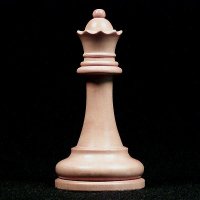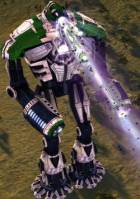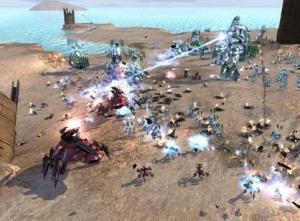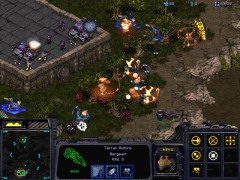SupCom 2 Speculation
I have high hopes for Supreme Commander 2, and as entertaining as the original was, it lacked the lasting appeal of its spiritual predecessor, TA. Luke already went over the problems with SupCom thoroughly and I must say he’s absolutely correct on all counts. Before starting in about what SupCom 2 might be like, I would like to add that possibly the biggest failing of the original was it wanted to be playable by casual strategy gamers. It could be said it failed, but it tried.
I understand that there are more casual strategy gamers than the “hardcore” RTS nuts, and to some extent it is necessary to cater to them to sell enough games to make it worth making. However TA was not a casual game, and it was the depth of play that turned its players from casual RTS gamers into hardcore players.
Sure, you lose a lot at first, but consider the extremes. Is a game better where the strong and the weak player have equal opportunity to win, or where the stronger player will win 100% of the time? I am of the opinion that the more skilled player should win to the degree of their skill – with the situation where one player will simply crush the other in every case is possible but rare (i.e. Starcraft pro vs player new to the genre). So as much effort as possible should be spent in making the game fun and interesting to play again and again, even at the expense of complexity and being difficult to learn. For those of you who play Dwarf Fortress, you know what I mean when I say more depth is better, even at the expense of graphics, and even if that depth will make you lose time and again. Indeed, in Dwarf Fortress you eventually lose every single game, but it’s still fun to play.
Supreme Commander 2 is a collaborative effort by Gas Powered Games and Square Enix, makers of Final Fantasy. I was quite surprised when I heard that they would be working together because at first the two studios appear to be fundamentally opposed in philosophy. Square Enix makes role playing games, and Gas Powered Games makes strategy games. However given GPG’s performance with Demigod, it appears they are trying to work elements of role-playing games into their strategy games. GPG also made Dungeon Siege, a respectable RPG title in its own right, so the two studios seem to fit together on a deeper level. Also, if I were Chris Taylor I would cast my eye on international markets for my next release, and the partnership with Square Enix gives better access to Japan, a large video game market. After some consideration, the partnership with Square Enix actually makes a lot of sense.
On to the game itself. Preliminary reports seem to show that Chris Taylor has listened to everything the fans said about the first game, and set about to remedy it post haste. One of the many reasons why he is at the head of the field in making RTS games. Based on the demo at E3 (http://www.youtube.com/watch?v=3dn6D3OCyrU) it appears as if there are a few new elements which could be problematic for a ‘purist’ RTS. My initial concern is that the “gameplay” modifications are last in the list of priorities after story, characters, graphics, and engine. Also, there seems to be the usual appealing to giant robot fans and heavy-duty hardware like lists of powers available to the commander or other units. In my opinion, nobody promotes Chess through exclamations about how powerful the Queen is!Also, the badass-ness of experimentals is touted as a selling point, the popup nature of the turrets is sold as being “cool” etc, etc. As awesome as it may be, the fact of the matter is that after your 100th multiplayer game and hearing the same sound bytes, nobody cares about how cool the turrets look because they’ve seen it a gazillion times. The same is true of a story line – a great story is amazing, but it only really contributes to the first play through. What they actually need is a game that is fun and interesting in gameplay, and stays that way for as long as possible.
Chris Taylor also says they have “fixed” the economy so you don’t stall. Stalling your economy was one of the central game concepts in TA and in SupCom. Attacking enemy resourcing was essentially the primary route to winning the game. A good analogue would be: the best way to win at poker is having better cards than the other guy in every hand. Reducing the enemy economy effectively allows a player to have a greater quantity of the same unit, or build more expensive units. Because of the efficiency of attacking the enemy economy, both players really should be attacking the enemy economy continuously for the entire duration of the game. If both players raid, and are able to defend against it effectively, the game is exciting and flows dynamically until one player does something brilliant, or someone makes a mistake. True, this means that the better player is more likely to win. This is a hard problem because on one level, having the superior player always win is an ideal case, however on another level having both players potentially be able to win regardless of their skill level is also an ideal. And so we arrive at the fundamental distinction between a hardcore game and a casual game. For a hardcore gamer, the more skilled player can, and should, always win, unless their opponent has the ability to make it an even contest. In a casual game, both players kinda just want to have fun and having one of them win all the time takes the wind out of their sails. GPG, I hate to break it to you, but you simply cannot have it both ways.
Now the experimental units deserve their own discussion. The experimental units were unfortunately the focus of SupCom simply because they were the top of the pyramid. There were an incredibly disproportionate number of experimentals in the demo, and I hope that was only because they wanted to showcase them. Everything before that can be one-upped by increasing tech level. Even without increasing tech level, sending your units across the field will mean they are going to encounter an enemy force which is equal in power plus whatever was built when your units were in transit. This means that SupCom was focused on a more passive game style, further emphasized by the availability of economic amplifiers called mass fabricators, allowing a down payment of mass and energy to reap long-term dividends provided you can protect it. Which, if you’re playing a passive game, is not terribly difficult to do. So the players “eco up”; build an immense amount of resource generation and production capacity, and then start producing experimentals – which they know cannot be “one-upped” as quickly as they can do it, and at a rate that increases throughout the course of the game. They know they will beat an opponent who wastes resources attacking their Great Wall of Turrets defense. Not that SupCom wasn’t fun, but I’m glad they are making SupCom 2 more engaging, faster.
I’m happy to say there is no question that SupCom 2 will fix some of the original’s issues. For example, units will be produced much more quickly. This will mean games get started earlier, and there is more interplay between players during the course of a game – always a good thing. Unfortunately they also said that a single game is likely to be relatively short, which is very bad, because it suggests that games will tend to follow a common formula, which is anathema to having an interesting game. Estimates for game lengths of 15 to 20 minutes make me worry for the integrity of the gameplay, especially when involving a progressive upgrade system.
The introduction of mini-experimentals might help ease the large discrepancy between tier-3 units and the big project experimentals, which is a plus. They also indicated that they intend to make the lower-tier units more useful at later stages in the game, which nearly made me jump for joy that they would remedy one of their game’s most critical flaws.
The performance increase is of utmost importance, and it looks like the game is less focused on graphics than SupCom 1 was in its day. Not to say the graphics look bad – they are certainly better than the original’s – but ogle-worthy graphics make for box art, not a compelling strategic gameplay experience. Case in point: Exhibit 1 entitled Super Unit A. Perhaps a more relevant example would be the original Starcraft, which still has legions of loyal
fans after all this time because its gameplay and balance are top notch. Compared to modern games, Starcraft’s graphics and sound are, let’s be honest, downright terrible. But none of that matters because Starcraft is simply more fun.
There are also a slew of new features being added which are very interesting. At the top of the list is the army-wide upgrade system allowing customization of an army on a grand scale. This is an interesting design choice. On the one hand this allows a player to mold their army to deal with a particular opponent, but on the other it also means that we might see a rise in “unit stockpiling” which then have upgrades applied across them. Supreme Commander and TA have in the past focused more on making units generic, consistent, and having a single role, which this upgrade system will tweak, possibly beyond recognition. We’ll have to see how it is implemented before passing judgment on whether this is a great idea, or a foolish one.
Also, apparently SupCom 2 will take a more modular approach to structures, where it is possible to build guns and shields on factories like attachable components. I like this as a concept, and I hope it is well executed. I suppose it’s possible to take it too far, although I don’t expect it. The basic idea of having an upgrade system is very appealing to me, however I dislike older implementations of upgrade systems like Age of Empires and Starcraft, which unfortunately SupCom 2 is almost sure to emulate. A tech-tree style progression seems very out of character for a very strategic gameplay-focused game. There is really no good game-design reason to arbitrarily limit the players’ choices and simply have all tech options available from square one. Any serious “tech-up” move should be simplified into as few steps as possible, and carry a high cost and high significance. Having a large number of tiny incremental upgrades like “10% better this” and “10% better that” seems pointless to me. Ideally, an upgrade should let you do something you could not do before. Games like Zelda and Metroid understand this concept well. Fortunately, I see there is at least an inkling of this idea in SupCom 2’s introductory media, such as upgrades to give tanks AA guns, or give the commander torpedoes or an ejection seat. This is the change I am most curious about, and it has great potential either to make or break SupCom 2.
SupCom as a series seems to be focusing on size and flash rather than substance and gameplay. Not that the gameplay will be shabby – SupCom 1 was entertaining, but it lacked the lasting impact of big RTS names like Starcraft and TA. Regardless, there is no question that Supreme Commander is pushing the RTS genre where it has never gone before, and to be honest I think that is a great feat in its own right. If we’re lucky, SupCom 2 will be creating something both innovative and great, instead of trying to recapture the glory days of Total Annihilation. Wouldn’t that be something?




Fantastic article Evan, i think this’ll spur a lot of my own thoughts on the matter. Curious, what do you think of the ‘tech tree’ and ‘minister’ (automation) systems employed in 2d or turn-based strategy games — such as Galactic Civilisations and Space Empires?
I am not familiar with either of those games, however I imagine both are similar in significant details to the Master of Orion series? Too many techs that each do too little alone. If designed properly, it should not require automation because each decision is strategically significant, and the system requires minimal attention beyond the actual choice. I will stand by what I said in the article- a good tech tree is full of new abilities rather than minute changes. Now, a statistical change can constitute a new ability, for example increasing a unit’s movement speed so it can outrun a particular other unit is a new ability even though it’s a statistical modification. That said, having a complex web of such statistical relations would be a nightmare to balance. Unique and special abilities are much easier to work with, even with many of them, although naturally a larger number requires more balancing.